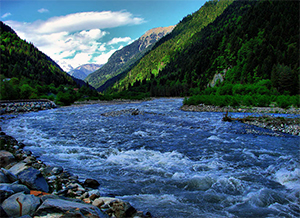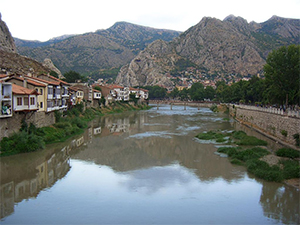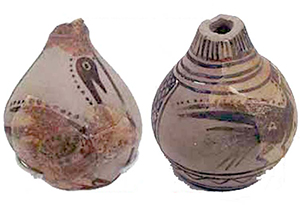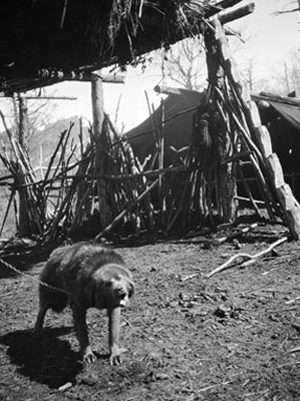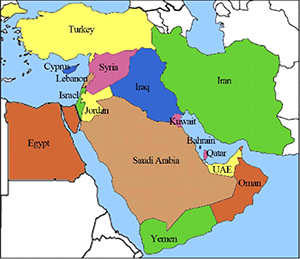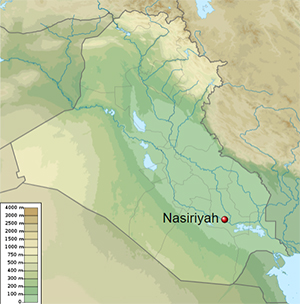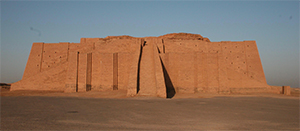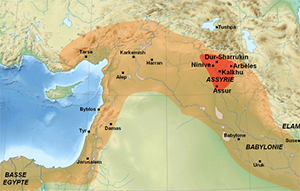Pezron
I took notice, when I was treating of the first apostasy, and rebellion upon earth, that it was a remarkable aera, when 1 [P. 16. 23. of this volume.] Scythismus was said to have commenced. This was attended with Hellenismus [Hellenism]; which by some is brought after; but seems to have prevailed about the same time. What the purport is of these terms has never been satisfactorily explained. In respect to Scythismus, we may be thus far assured, that it is a term which relates to a people styled Scythae; and they were the same, from whom the region called Scythia had its name. There were several countries of this denomination: but what relation could the people have with Babylonia? and how can we imagine, that their history could precede the aera of dispersion?
As I am therefore about to treat of these nations, it will be proper to say something of the learned Monsieur Pezron, whose notions upon this head are remarkable. He seems to have been the founder of a new system; in which he has had many followers: and all that science, which I suppose to have been derived to the western world from Babylonia, and Egypt, they bring from the Sacae, and Scythians of the north: making it take its rise beyond Media and Mount Imaus, in the upper regions of Asia. We are particularly informed by Pezron, that there was a people in these parts, who in the first ages spread themselves over Bactria, and Margiana; and proceeding by Armenia and Cappadocia, at last passed over into Europe. The whole of this continent they conquered, and held, under the names of Gomarians, Cimmerians, Celts, and Scythae. From hence he takes upon him to shew, that the Gaulish and Celtic nations were from the upper regions of Asia; and particularly from those countries, which lay beyond the Bactrians and Medes. He takes notice, that there was in these parts a city named Comara, mentioned by Ptolemy, and others; and from the similitude, which subsists between Comarians and Gomarians, the learned writer is induced to bring the sons of Gomer, by whom Europe is supposed in part to have been peopled, from the regions about Thebet and Tartary. As he proceeds methodically in the history of this people, I will lay before the reader an epitome of what he advances; and this in as precise, and fair a manner, as I am able.
2 [See Chap. 3. 4. 5. 6. of Monsieur Pezron's work, entitled, The Antiquities of Nations; more particularly of the Celts and Gauls: by Monsieur Pezron, Doctor in Divinity, and Abbe of La Charmoye. Englished by Mr. Jones, 1706.] The Comarians, (says Pezron), are by Ptolemy placed in Bactriana, near the sources of the Iaxartes, towards the most eastern boundaries of 3 [C. 3. p. 18.] Sogdiana: and they are represented as a powerful and warlike people. They passed the mountains of Margiana, and made an irruption into that country. It was then in the possession of the Medes called Arii: but they were afterwards styled Parthians; a name imposed by the conquerors. By this is meant persons PARTED, or SEPARATED; from the Celtic word to PART: because they were expelled, and severed from their country. These separatists in return, finding that they could not retaliate, but by abusive language, called the others by way of ridicule SCACAE, or SACAE, meaning by it Noxii, Latrones, SACKERS; PEOPLE, WHO SACK AND SLAY. These Sacae seized upon Bactriana, and made themselves masters of the most eligible part of Armenia, which they called Sacasene, after the name, which had been given to themselves. They afterwards passed into 4 [Josephus and Syncellus make the Gomerians the first inhabitants of Cappadocia. [x]. Syncell. p. 49. They were the people attacked by the Sacae, who seized upon the best of the country.] Cappadocia; and took possession of all that part, which lay upon the Euxine Sea. The person, who conducted them in these enterprises was one Acmon. This name occurs in Stephanus, who mentions, that a city in Phrygia was built by 5 [Of Acmon I have before spoken in my second volume. Acmon was a title of the Deity. [x], Heysch.] Acmon; and styles him [x], Acmon, the son of Man, or Maneus. It is likely that Acmon, or Ach-Man, as perhaps the word was pronounced by the Sacae, signified properly the son of man, or of the race of man.
In the mean time the Cimmerians, who were of the same family, went by the north; and having made various incursions, at last settled above the Euxine Sea, near the Palus Maeotis. If any should be dissident about what is here advanced, let him consult Plutarch, Posidonius, Diodorus, and Strabo.
Thus, (says Pezron), have I conducted the Sacae from their original place of residence to Armenia and Cappadocia: but as if this 6 [C. 8. P. 45.] famous nation were of a sudden lost, we hear no more of them. Their name seems to be quite extinct; and the people annihilated. And here a discovery is to be made of matters, which have lain concealed from all ancient historians. I [Pezron] am now to bring to light many great and important truths, which they could never arrive at. After the Sacae had entered Upper Phrygia; as if they had gone into another world, they quitted their ancient name, which they probably detested, and were now called Titans. I never could comprehend, why they took the name; whether it was through some mystery, or a mere caprice, that they affected it; or to make themselves 7 [C. 8. p. 46.] formidable. These events were long before the war of Troy. The conquests of Acmon were prior to the birth of Abraham, and the foundation of the 8 [C. 8. p. 48. Even Uranus is by this writer supposed to have been before Abraham. C. 12. p. 83.] Assyrian monarchy. This prince was succeeded in his kingdom by Uranus, who conquered Thrace, Greece, and the island Crete; and afterwards fell violently upon the other provinces of Europe; and carried all before him to the uttermost boundaries of Spain. He also subdued Mauritania. Uranus was succeeded by Saturn; and Saturn by Jupiter, who was three hundred years before Moses. This last entrusted one part of his vast empire to his brother Pluto, and another to his cousin-german Atlas, who was styled Telamon. He was a person of high feature: and Telamon in the language of Jupiter signified a 9 [C. 12. p. 84.] TALL MAN; TELL being TALL, and MON signifying MAN.
In this detail there are many exceptionable positions; which are too palpable to need any discussion. I shall therefore take notice only of some of the principal facts, upon which his system is founded. He tells us, that while the Sacae were proceeding by the south, the Cimmerians, who likewise came from Bactriana, are supposed to take their rout by the north of Asia: and they are represented as making their way by force of arms, till they settled upon the 10 [Herodotus makes mention of the march of the Cimmerians: and proves it to have been in a quite contrary direction, from the Palus Maeotis towards Caucasus, and the east. L. 4. c. 12.] Palus Maeotis. And it is requested by Pezron, if any should doubt the truth of what he advances, that they would apply to the best Grecian historians. But these writers have not a syllable to the purpose. That there were such a people as the Cimmerians upon the Maeotis is as certain, as that there were Phrygians in Troas, and Spartans at Lacedaemon. But that they came from Bactria, and fought their way through different countries; that they were the brethren of the 11 [Strabo says, the Cimmerians were driven out of their country by the Scythians. [x]. L. 1. p. 756.] Scythians styled Sacae, and took the upper rout, when the others were making their inroad below; are circumstances, which have not the least shadow of evidence. They are not mentioned by the authors, to whom he appeals: nor by any writers whatever. The conquests of Uranus, and the empire given to Jupiter, are incredible. It would be idle to trouble ourselves about a circumstance, which does not merit a serious confutation. The conquests of Osiris, and Sesostris, have as good title to be believed. To these we might add the exploits of the great prince Abcamaz, who ruled over the whole earth. His rib was shewn to the 12 [Benjamin Tudelensis. p. 56.] Jew of Tudela at Damascus: and by the most exact measurement it was nine spans long, and two in breadth; so that his stature was in proportion to his dominions. But setting aside these fabulous histories, which confute themselves, let us examine one circumstance in the account of the learned Pezron, upon which his whole system depends. He tells us, that after the Sacae had entered Cappadocia, they seemed in a manner extinct: but they appeared again under the name of Titans; and carried on their conquest under the same hero Acmon. This, he says, is a discovery of the greatest importance, which was unknown to every ancient historian, and had lain dormant for ages. And for the history of the Sacae he appeals to Strabo; and particularly concerning their inroad into Cappadocia, from whence they are supposed to have proceeded to the conquest of all Europe. But in the execution of this grand and pleasing scheme, he is guilty of an oversight, which ruins the whole of his operations. Carried on by a warm imagination, he has been erecting a baseless fabric, which cannot subsist for a moment. The passage in Strabo, upon which he founds his notions, makes intirely against him. This writer speaks thus of the Sacae. 13 [L. 11. p. 779.] [x]. The excursions of the Sacae were like those of the Cimmerians. In this description the author refers to a prior circumstance. Now the excursions of the Cimmerians were in the reign of 14 [Herodotus. L. 1. c. 6. 15. 16.] Ardys, the son of Gyges, king of Lydia, long after the Trojan war, and still farther removed from Abraham, and the supposed foundation of the Assyrian empire. And in proof of this being the author's meaning we find him afterwards more explicitly shewing, that these excursions of the Sacae were as late as the empire of the Persians. The account is so particular, and precise, that I will lay it at large before the reader.
15 [L. 11. p. 779. [x]. Ibid.] The inroads of the Sacae were very like those of the Cimmerians, and Treres; some of them being made to a great distance, and others nearer home. For they not only got possession of Media; but also seized upon the most eligible part of Armenia, which they called Sacasene after their own name. They advanced as far as Cappadocia; especially towards that part of it, which borders upon the Euxine sea, and is called the region of Pontus.
Thus far all is right: but observe the sequel.
Here, as they were giving themselves up to feasting and jollity from the plunder, which they had taken, they were set upon in the night by some of the Persian Satrapae, and all cut off.
Pezron therefore might well say, that the Sacae in the midst of their exploits seem at once to have been annihilated, and their name extinct. Strabo tells us, that they were totally ruined: [x]: the Persians cut them all off to a man. Hence we may see of what great oversights this learned man was guilty in the prosecution of his scheme. First, in supposing these Sacae to have been of as great antiquity as the Patriarchs [Narrowly, Abraham, his son Isaac, and Isaac's son Jacob, also named Israel; widely, the twenty male ancestor-figures between Adam and Abraham. The first ten are the antediluvian patriarchs,], and antecedent [before] to the foundation of Assyria, who were manifestly as late as the reign of 16 [Strabo says, that according to some historians, it was Cyrus, who cut them off. L. 11. p. 780. But it was probably an age later, when the Persian empire was more established. See the passage: [x]. See also Diodorus Sic. L. 2. p. 119.] Cyrus [Cyrus the Great 600-530 BC]. Secondly, in giving the character of universal conquerors to a set of banditti, who in one attack were extirpated. Lastly, in attributing the most material circumstances in the ancient history of Europe to a people, who were never there. Thus is this fairy vision brought to an end. The history of the Titans, the achievements of Acmon, the empire of Jupiter, the part delegated to Tal-man, are quite effaced: and much labour and ingenuity has been expended to little purpose. In short, the whole Celtic system is ruined: for the Sacae, upon whom it depended, are stopped in their career, and no more heard of: and all this is manifest from the authorities, to which Pezron appeals. Such too frequently are the quotations made use of by people of an eager disposition; which, as they are introduced, answer but in part; when examined, are totally repugnant. His reasoning throughout is carried on by a chain, of which not one link is fairly connected.
In the eighth century BC, Scythian warriors pursuing the Cimmerians rode south out of the steppes into the Near East in the area of northern Iran. They defeated the Cimmerians in the 630s and in the process conquered the powerful nation of the Medes, their Iranic ethnolinguistic relatives…. When they were defeated by the Medes in about 585 BC, they withdrew to the north and established themselves in the North Caucasus Steppe and the Pontic Steppe north of the Black Sea. They and their relatives built a huge empire stretching across Central Eurasia as far as China, including most of urbanized Central Asia, and grew fabulously rich on trade.
The Scythians and other North Iranic speakers thus dominated Central Eurasia at the same time that their southern relatives, the Medes and Persians, formed a vast empire based in the area of what is now western Iran and Iraq… they and other North Iranic-speaking relatives -- including their eastern branch, the Sakas -- continued to rule much of Central Eurasia for many centuries…
-- Greek Buddha: Pyrrho's Encounter With Early Buddhism in Central Asia, by Christopher I. Beckwith
The Scythians, also known as Scyths, Saka, Sakae, Iskuzai, or Askuzai, were an ancient nomadic people of Eurasia, inhabiting the region Scythia. Classical Scythians dominated the Pontic steppe from approximately the 7th century BC until the 3rd century BC. They can also be referred to as Pontic Scythians, European Scythians or Western Scythians. They were part of the wider Scythian cultures, stretching across the Eurasian Steppe. In a broader sense, Scythians has also been used to designate all early Eurasian nomads, although the validity of such terminology is controversial. According to Di Cosmo, other terms such as "Early nomadic" would be preferable. Eastern members of the Scythian cultures are often specifically designated as Sakas.
The Scythians are generally believed to have been of Iranian (or Iranic; an Indo-European ethno-linguistic group) origin; they spoke a language of the Scythian branch of the Iranian languages, and practiced a variant of ancient Iranian religion. Among the earliest peoples to master mounted warfare, the Scythians replaced the Cimmerians as the dominant power on the Pontic steppe in the 8th century BC. During this time they and related peoples came to dominate the entire Eurasian Steppe from the Carpathian Mountains in the west to Ordos Plateau in the east, creating what has been called the first Central Asian nomadic empire. Based in what is modern-day Ukraine and southern Russia, they called themselves Scoloti and were led by a nomadic warrior aristocracy known as the Royal Scythians.
In the 7th century BC, the Scythians crossed the Caucasus and frequently raided the Middle East along with the Cimmerians, playing an important role in the political developments of the region. Around 650–630 BC, Scythians briefly dominated the Medes of the western Iranian Plateau, stretching their power to the borders of Egypt. After losing control over Media, they continued intervening in Middle Eastern affairs, playing a leading role in the destruction of the Assyrian Empire in the Sack of Nineveh in 612 BC. The Scythians subsequently engaged in frequent conflicts with the Achaemenid Empire, and suffered a major defeat against Macedonia in the 4th century BC and were subsequently gradually conquered by the Sarmatians, a related Iranian people living to their east. In the late 2nd century BC, their capital at Scythian Neapolis in the Crimea was captured by Mithridates VI and their territories incorporated into the Bosporan Kingdom. By this time they had been largely Hellenized. By the 3rd century AD, the Sarmatians and last remnants of the Scythians were dominated by the Alans, and were being overwhelmed by the Goths. By the early Middle Ages, the Scythians and the Sarmatians had been largely assimilated and absorbed by early Slavs. The Scythians were instrumental in the ethnogenesis of the Ossetians, who are believed to be descended from the Alans.
The Scythians played an important part in the Silk Road, a vast trade network connecting Greece, Persia, India and China, perhaps contributing to the prosperity of those civilisations. Settled metalworkers made portable decorative objects for the Scythians, forming a history of Scythian metalworking. These objects survive mainly in metal, forming a distinctive Scythian art....
In the aftermath of conflict between Macedon and the Scythians, the Celts seem to have displaced the Scythians from the Balkans; while in south Russia, a kindred tribe, the Sarmatians, gradually overwhelmed them. In 310–309 BC, as noted by Diodorus Siculus, the Scythians, in alliance with the Bosporan Kingdom, defeated the Siraces in a great battle at the river Thatis.
By the early 3rd century BC, the Scythian culture of the Pontic steppe suddenly disappears. The reasons for this are controversial, but the expansion of the Sarmatians certainly played a role. The Scythians in turn shifted their focus towards the Greek cities of the Crimea.
-- Scythians, by Wikipedia
An ingenious writer, and antiquary of our own nation has followed the steps of Pezron, and added to his system largely. He supposes, that all science centered of old in Bactria, called 17 [See the History and Chronology of the Fabulous Ages, by Wise. p. 119. and note (1) in another treatise, he says: Pezron proves, that Uranus, Caelus, Saturn, and Jupiter, were no imaginary beings; but the true names of Celtic emperors, who were more generally known by the name of Titans. Wise. Dissertation on the Language, Learning, &c. of Europe. It appears, that Uranus, Saturn, and Jupiter, were powerful princes; sovereigns over a vast empire, comprehending all Europe, and a great part of Asia. Ibid. p. 55. These writers were too modest in limiting Jupiter's empire, which they might as well have extended over all the earth; especially as they might have quoted authority for it. [x]. Diodorus. L. 3. p. 194.] Bochary, or the Land of Books; [in Bactria], which Pezron had supposed to have been the principal place of residence of his Sacae. He accordingly tells us, that in these parts we must look for the origin of the Titans, Celts, and Scythae. We are likewise informed by another writer, that near Cashemise and Thebet they speak good 18 [See Parsons, in his treatise styled Japhet.] Irish at this day. The learned Salmasius also deduces every thing from Scythia.19 [De Hellenestica. p. 366.] Nulla fere Europae gens nec Asiae, quin a septentrione promanaverit, &c. Scythia igitur, quae ad septentrionem, omnes fere gentes evomuit. [Google translate: There is almost no European or Asian nation without the north he has flowed, &c. Scythia, then, to the north it spewed out almost all nations.]
3. The Oriental System
Boosted by seventeenth-century Jesuits like Rodrigues, Kircher, and Charles Le Gobien, the notion of a pan-Asian "oriental system" or doctrina orientalis with possible Mesopotamian or Egyptian roots became a major factor in eighteenth-century views of Asian religions. Facets of this complex of ideas include theories of an Egyptian origin of Buddhism (Kircher, Mathurin Veyssiere de La Croze, Engelbert Kaempfer, Johann Jacob Brucker, Diderot), the view that Brahmanism is a form of exoteric Buddhism (Diderot, Herder, etc.), the notion that some Buddhist texts of China are translations from the Veda (Joseph de Guignes), and the suspicion that Greek philosophy and particularly Plato were inspired by oriental ideas (A. M. Ramsay) or even by Buddhism (la Crequiniere). The "inner" teachings of this doctrina orientalis were first modeled on the purported monism, emanatism, and "quietism" of Japanese Zen Buddhism and later also of Vedanta and Sufism. In 1688 Francois Bernier linked such oriental quietism to the teachings of Miguel de Molinos, Francois Fenelon, and Madame Guyon as well as the philosophy of Spinoza.
The "Spinoza" article in Bayle's dictionary of 1702 -- one of the most famous and controversial articles in one of the most noted works of eighteenth- century Europe -- is a good example for both the broad use of missionary and secular sources about Asia and the deep influence of the linkage between features of Asian religions and raging theologico-philosophical controversies of Christian Europe. Bayle's influence is palpable not only in Brucker's influential histories of philosophy of the 1730s and 1740s and in Diderot's articles for the Encyclopedie of the 1750s, but also in Johann Lorenz Mosheim's Ecclesiastical History of 1755, Francois Pluquet's Examen du fatalisme of 1757, and many later European works including Herder's philosophy of history (1784-91) and Friedrich Schlegel's pioneering work on the language and wisdom of the Indians (1808). Schlegel, with Volney one of continental Europe's first students of Sanskrit, saw this doctrina orientalis as the ultimate source not only of Oriental philosophy and religion but also of their ancient Greek counterparts (Schlegel 1808:114-23).
At the beginning of the nineteenth century, India had thus for some become not only the cradle of human civilization, as Voltaire had so insistently argued, but of all ancient religion and philosophy -- a notion that inspired Europe's romantic indomania. The birth of modern Orientalism is intimately linked to this idea of Indian origins as an alternative to the biblical narrative. It is not by chance that one of the most ardent propagators after Voltaire of Indian origins was Louis Langles, director of Bible-independent Orientalism's first institution on European soil, the Ecole Speciale des Langues Orientales Vivantes, founded in 1795.
4. Emanation and Transmigration
Bayle (1702), Brucker (1744), Pluquet (1757), F. Schlegel (1808), and many others identified two of the core features of the "oriental doctrine" as emanation and metempsychosis or transmigration of souls. Both were linked to Platonism, pantheism, and Spinozism; thus, they aroused much discussion when all these came under increasing attack. Bayle's 1702 article on Spinoza explicitly established this link in combining information about Greek philosophers and Christian heretics with extensive data from the Orient (Francois Bernier, Philippe Couplet, Simon de La Loubere, Louis Daniel Le Comte, Le Gobien, Antonio Possevino, Guy Tachard) and became a central source not only for Brucker's and Mosheim's discussion of "oriental doctrine" but also for Diderot's article on "philosophie asiatique" (1751) that is discussed in Chapter 3.
In the course of the eighteenth century, the old idea that emanation and transmigration had been brought by Pythagoras via Egypt to India got reversed, and India became the ultimate point of origin. Emanation and the thought of a first principle adopting myriad forms had long been linked to the teaching of Buddha, as was the doctrine of transmigration. The idea of the Egyptian origin of such teachings (and by consequence also of Buddhism) -- which had prominent supporters like Kircher (1667), La Croze (1724), Kaempfer (1729), and Brucker (1744) -- lingered on, but in the second half of the eighteenth century, the notion of an Indian cradle carried the day.
Regardless of such controversies about origins, it can be said that, from the sixteenth to the nineteenth centuries, the doctrines of emanation and transmigration constituted a crucial link between East and West extending from Japan in the Far East (where these two ideas had since the sixteenth century been associated by missionaries with the esoteric and exoteric teachings of Xaca or Buddha) via China, Vietnam, Siam, India, and Persia to Egypt and Greece. In the thought of Ramsay (Chapter 5) and Holwell (Chapter 6), this link took on a particularly poignant form since these authors identified transmigration as a most ancient and universal pre-Mosaic teaching concerning the fall of angels before the creation of the earth -- a teaching that in their view forms the initial part of the biblical creation story that Moses omitted.They regarded human souls as the souls of fallen angels imprisoned in human bodies who have to migrate from one body to the next until they achieve redemption and can return to their heavenly home.
-- The Birth of Orientalism, by Urs App
GAUTAMA BUDDHA, THE SCYTHIAN SAGE
The dates of Gautama Buddha are not recorded in any reliable historical source, and the traditional dates are calculated on unbelievable lineages including round numbers such as one hundred, so they are not reliable either, as noted already by Fleet, Hultzsch, and many others. His personal name, Gautama, is evidently earliest recorded in the Chuangtzu, a Chinese work from the late fourth to third centuries BC. His epithet Sakamuni (later Sanskritized as Sakyamuni), 'Sage of the Scythians ("Sakas")', is unattested in the genuine Mauryan inscriptions or the Pali Canon. It is earliest attested, as Sakamuni, in the Gandhari Prakrit texts, which date to the first centuries AD (or possibly even the late first century BC). It is thus arguable that the epithet could have been applied to the Buddha during the Saka (Saka or "Indo-Scythian") Dynasty -- which dominated northwestern India on and off from approximately the first century BC, continuing into the early centuries AD as satraps or "vassals" under the Kushans -- and that the reason for it was strong support for Buddhism by the Sakas, Indo-Parthians, and Kushans.
However, it must be noted that the Buddha is the only Indian holy man before early modern times who bears an epithet explicitly identifying him as a non-Indian, a foreigner. It would have been unthinkably odd for an Indian saint to be given a foreign epithet if he was not actually a foreigner. Moreover, the Scythians-Sakas are well attested in Greek and Persian historical sources before even the traditional "high" date of the Buddha, so the epithet should presumably have been applied to him already in Central Asia proper or its eastern extension into India-eastern Gandhara. There are also very strong arguments -- including basic "doctrinal" ones -- indicating that Buddhism had fundamental foreign connections from the very beginning, as shown below. It is at any rate certain that Buddha has been identified as Sakamuni ~ Sakyamuni "Sage of the Scythians" in all varieties of Buddhism from the beginning of the recorded Buddhist tradition to the present, and that much of what is thought to be known about him can be identified specifically with things Scythian. [The tradition by which Buddha was from a local Nepalese Sakya "clan" in the area of Lumbini is full of chronological and other insuperable problems, as shown by Bareau (1987); it is a very late development.]
Moreover, it must not be overlooked that we have no concrete datable evidence that any other wandering ascetics preceded the Buddha. The Scythians were nomads who lived in the wilderness, and it is thus quite likely that Gautama himself introduced wandering asceticism to India, just as the Scythians had earlier invented mounted steppe nomadism. One way or the other, it would seem that the Buddha's teachings were unprecedented mainly because they opposed new foreign ideas -- the Early Zoroastrian ideas of good and bad karma, rebirth in Heaven (for those who were good), absolute Truth versus the Lie, and so on -- which were previously unknown in "India proper". He did this because he himself was foreign, and people actually understood and accepted that by calling him Sakamuni.
-- Gautama Buddha, The Scythian Sage, Excerpt from Greek Buddha: Pyrrho's Encounter With Early Buddhism in Central Asia, by Christopher I. Beckwith
But what are we to understand by Scythia? It is an unlimited, undefined term, under which Grecian ignorance sheltered itself. Whatever was unknown northward was called Scythian. It is certain, that vast bodies of men have at times come from the north: though Salmasius carries his notions to a degree of extravagance. But giving his opinion a full scope, What has this to do with the language and learning of Europe; which by many are so uniformly deduced from the same quarter? It is notorious, that this vast track of country called ignorantly Scythia, was possessed by people essentially differing from one another. Timonax, a writer of great antiquity, took notice of fifty nations of 20 [[x]. Scholia in Apollon. L. 4. v. 320.] Scythians. Mithridates had twenty-two 21 [Mithridates duarum et viginti gentium Rex, totidem linguis jura dixit [Google translate: Mithridates, king of twenty-two nations, spoke the same rights in as many languages.]. Plin. L. 7. c. 24. p. 387. See Aulus Gellius. L. 17. c. 17. There were twenty-six languages among the Albani. Strabo. L. 11. p. 768. See also Socratis Hist. Eccles. L. 1. c. 19. p. 49. [x].] languages spoken within his territories, most of which were esteemed Scythic. The people of Colchis at one time carried on a great trade; and variety of inland nations came down to their marts. According to Timosthenes, they were not less than three hundred, which had each their particular 22 [Plin. 1. 5. c. 5. p. 305. Many of these were probably only dialects. Yet there must have been in some instances a real difference of language; and consequently a distinction of people.] language. And even afterwards, in the times of the Romans, it is said, that they were obliged to keep up an hundred and thirty interpreters to carry on traffic. Yet we are apt to speak of the Scythians collectively as of one family, and of one language, and this the Titanian or Celtic.
23 [P. 56.] The Titan language, (says Wise), was universal in Europe: the Titan language, the vehicle of all the knowledge, which dawned in Europe. — The Titans, masters of all the knowledge derived from the sons of Noah.
And who these Titans were, he repeatedly shews, by saying,
that they were the first civilizers of mankind, and Scythians.
The true Scuthai, or Scythians, were undoubtedly a very learned and intelligent people: but their origin is not to be looked for in the north of Asia, and the desarts of Tartary. Their history was from another quarter, as I purpose to shew. How can we suppose one uniform language to have been propagated from a part of the world, where there was such variety? And how could this language be so widely extended, as to reach from Bactria to Thrace, and from thence to the extremities of Europe? What adds to the difficulty is, that all this was effected, if we may believe our author, six hundred years before Moses. Then it was, that Jupiter subdued all Europe from Thracia to Gades. As to the learning supposed to be derived from these Scythians, it is certainly a groundless surmise. The greater part of these nations commonly styled Scythic, were barbarous to the last degree. There are no monuments, nor writings, remaining, nor any upon record, which can afford us the least idea of their being liberal, or learned.
We know of not one but two great Scythian philosophers…
Anacharsis was the brother of Caduida, king of the Scythians. He spoke Greek because his mother was a Greek.
In about the forty-seventh Olympiad (592-589 BC), the age of Solon, he travelled to Greece and became well known for his astute, pithy remarks and wise sayings…. For example, "He said he wondered why among the Greeks the experts contend, but the non-experts decide."
The Greeks regularly quoted this and other pithy sayings of Anacharsis, which taken together are unlike those of any other known figure, Greek or foreign, in ancient Greek literature. Though he was considered to be a Scythian, the Greeks liked him, and he was counted as one of the Seven Sages of Antiquity in Greek philosophy. His own literary works are lost, but his fame was such that other writers used him as a stock character in their own compositions.
Sextus Empiricus, in his Against the Logicians, quotes an otherwise unknown work attributed to Anacharsis, on the Problem of the Criterion:
Who judges something skillfully? Is it the ordinary person or the skilled person?...
The argument is also strikingly close to the second part of the argument about the Problem of the Criterion in the Chuangtzu. Exactly as in the genuine saying of Anacharsis and in the argument attributed to him by Sextus Empiricus, the Chinese argument specifically concerns the ability to decide which of two contending individuals is right:
If you defeat me, I do not defeat you, are you then right, and I am not? If I defeat you, you do not defeat me, am I then right, you are not?...
The explanation for the similarity of these two passages could well be that the author of the "Anacharsis" quotation given by Sextus Empiricus had heard just such an argument, directly or indirectly, from a Scythian. This would have been a simple matter during the Classical Age because many Scythians then lived in Athens, where a number of them even served as the city's police force. If it was a stock Scythian story, an eastern Scythian -- a Saka -- could have transmitted a version of it to the Chinese, so that it ended up in the Chuangtzu, which is full of stories and arguments of a similar character.
Whatever the explanation, the explicit Greek connection of this story with a Scythian philosopher known for pithy sayings having a clever argument structure clearly indicates that it is the kind of thing Scythians were expected to say. In view of the Chinese testimony, it seems likely that it was something that some Scythians actually did say.
GAUTAMA BUDDHA, THE SCYTHIAN SAGE...
-- Greek Buddha: Pyrrho's Encounter With Early Buddhism in Central Asia, by Christopher I. Beckwith
The Huns and Avares were of these parts; who overran the empire in the fourth century: but their character had nothing in it favourable. They were so rude in feature and figure, and such barbarians that they were not thought human.24 [Jornandes de Rebus Geticis. p. 104.] It was a common notion, that they were begotten by devils upon the bodies of some savage hags, who were found wild in the woods. Procopius says, that they neither had letters, nor would hear of them: so that their children had no instruction. He calls them 25 [Procopius. Bell. Goth. L. 4. c. 3. L. 4. c. 19.]; quite deaf, and averse to all science. In short, all the Tartarian nations of old 26 [I say of old: for there have in later times been some instances to the contrary.] seem to have been remarkably rude. But it may be said, that the people spoken of by Pezron and Wise were of Bactria and Margiana. They may place them as they please: still they are no other than the Sacae Nomades; a Tartarian clan, who from Strabo appear to have been in a continual roving state, till they were cut off. But after all, who in their senses would think of looking for the Titans among the Tartars, or deduce all science from the wilds of Margiana? But if these countries had all the learning, that ever Egypt or Greece boasted, how was it transmitted to Europe? How could it be derived to us, when so many, and such mighty, nations intervened? We have seen the plan adopted by Pezron; which was found defective from the very authorities, to which he appealed: and Wise proceeds upon the same system. These were both in their time respectable persons on account of their learning: but they have certainly lowered themselves by giving into these idle reveries. What can be more fallacious than the notion adopted by 27 [Religion and Learning of Europe, p. 9.] Wise, of the antiquity of the Scythians from the height of their ground?
Which height, (he says), the Scythians urged in their dispute with the Egyptians, as a chief argument of the antiquity of their nation: and the Egyptians, at least other good judges, acquiesced in the proof.
The notion was, according to Justin, from whom it is borrowed, that, as the earth was once overflowed, the higher grounds emerged first, and consequently were first inhabited. And that Scythia was the higher ground, they proved from this; because all the rivers of Scythia descended from the north to the south, and ran towards Egypt. 28 [Justin. L. 2. c. 1.] Porro Scythiam adeo editiorem omnibus terris esse, ut cuncta slumina ibi nata in Maeotim, tum deinde in Ponticum, et AEgyptium mare decurrant [Google translate: Further to Scythia it is so much higher than all the earth that all the rivers are there she was born in the Azov Sea, then into the Black Sea and the Egyptians the sea flowing through.]. What a strange proof is this? and what an argument to be laid before the Egyptians? They lived upon the Nile; and from the same principles might draw a different conclusion. As their river ran in a contrary direction, from south to north, they had the same reason to 29 [The Egyptians did insist upon it. See Diodorus. L. 1. p. 10.] insist, that Upper Egypt, and Ethiopia were the higher grounds, and the more ancient countries. And they would be so far in the right, as the earth is certainly higher, as we advance towards the equator, than it is towards the poles.
The highest point on the equator is at the elevation of 4,690 metres (15,387 ft), at 0°0′0″N 77°59′31″W, found on the southern slopes of Volcán Cayambe [summit 5,790 metres (18,996 ft)] in Ecuador. This is slightly above the snow line and is the only place on the equator where snow lies on the ground.
-- Equator, by Wikipedia
[Mount Everest] is Earth's highest mountain above sea level, located in the Mahalangur Himal sub-range of the Himalayas. The China–Nepal border runs across its summit point. Its elevation (snow height) of 8,848.86 m (29,031.7 ft) was most recently established in 2020 by the Chinese and Nepali authorities.
-- Mount Everest, by Wikipedia
As to the Tanais running from north to south, and so entering the Palus Maeotis, and Pontus Euxinus; it is well known, that there are many rivers upon the coast of the Black Sea, which run in various and contrary directions: consequently different countries must be equally supereminent, and have the same title to be the most ancient; which is absurd and a contradiction.
The whole of Armenia appears to have been fruitful; and we have the attestation of Strabo that it produced the olive. It seems, for the most part, to have been of a very high situation. One province was styled, on this account, Armenia Alta. It bordered upon Araratia westward; and the account given of it by Moses Chorenensis is remarkable.Armenia Alta is one of the highest regions in the world; for it sends out rivers in contrary directions towards the four cardinal points in the heavens. It has three mountains, and abounds with wild animals, and species of fowl for food, also with hot baths, and mines of salt, and with other things of utility; and the chief city is called Carina.
The region styled Araratia was also very high, though it had fine plains and valleys between the mountains. A country of this nature and situation must, after the flood, have been soonest dried, and consequently the soonest habitable. And it seems also, in an eminent degree, to have contained every requisite for habitation. The mountain still has the name of Ararat, which it has retained through all ages; and the province beneath is at this day peculiarly styled Ar-Meni. This name seems by the natives to have been originally limited to the region of the ark; but writers in after times have spoken of it with a greater latitude, and extended it to a large country. It was of great repute, and its chief city very ample, before it was ruined by the Tartars.
-- Of the Migration and Dispersion of Nations, from A New System, Or, An Analysis of Ancient Mythology: Wherein an Attempt is Made to Divest Tradition of Fable; and to Reduce the Truth to its Original Purity, by Jacob Bryant
The learned Pezron argues no better, when he tries to shew the similitude, which subsisted between the Sacae, and the ancient Gauls. He takes notice from Herodotus, that the Amyrgian Sacae wore breeches like the Gauls: and having observed, that they were an enterprising people, and given an account of their dress, and arms; he concludes by saying,
We may upon the whole find in these Gomarians of Margiana the language, arms, habit, with the restless and warlike spirit of our ancient Celtae. Will any body take upon him to deny, that they came originally from this Asiatic nation?
Yet after all, I cannot assent; for I do not see the resemblance: and the authority upon which I proceed, is that of Herodotus, to whom he sends me. This author takes notice both of the Bactrians, and the Sacae. He says, that the Bactrians were archers, and used bows made of their country reed, or cane; and had short darts. In other respects, they were accoutered like the Medes, who wore tiaras, tunics, and breeches, with a dagger at their girdle. The Sacae, or Amyrgians, had caps upon their heads, which terminated above in a point: they had also breeches. Their chief arms were bows and arrows with a dagger; also battle-axes, and sagars. Let us now turn, and view the habiliments of the Celtae; and see if any resemblance subsisted. Their chief weapons, according to Polybius, Livy, and Caesar, were a long dart, or sramea; and a long cutting sword, but pointless: and they used an immense shield, which covered the whole body. They had helmets upon their heads, which were ornamented with the wings of a bird for a crest; or else with the horns of some wild animal. To bows and arrows they were strangers, or did but seldom use them. From hence we may see, that they were in nothing similar, but breeches and bravery: and of the former they were diverted, when they fought; for they went into battle naked.
La Tène metalwork in bronze, iron and gold, developing technologically out of the Hallstatt culture, is stylistically characterized by "classical vegetable and foliage motifs such as leafy palmette forms, vines, tendrils and lotus flowers together with spirals, S-scrolls, lyre and trumpet shapes". Such decoration may be found on fine bronze vessels, helmets and shields, horse trappings, and elite jewelry, especially torcs and fibulae. Early on, La Tène style adapted ornamental motifs from foreign cultures into something distinctly new; the complicated brew of influences include Scythian art as well as that of the Greeks and Etruscans, among others.
-- Gauls, by Wikipedia
Great respect is certainly due to men of learning; and a proper regard should be paid to their memory. But they forfeit much of this esteem, when they misapply their talents; and put themselves to these shifts to support an hypothesis. They may smile at their reveries, and plume themselves upon their ingenuity in finding out such expedients: but no good can possibly arise from it; for the whole is a fallacy, and imposition. And a person who gets out of his depth, and tries to save himself by such feeble supports, is like an idiot drowning, without knowing his danger: who laughs, and plunges, and catches at every straw. What I have said in respect to these two learned men, will, I hope, be an argument to all those, who follow their system.

